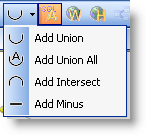A Union operator joins the results of rows from two or more SELECT statements. Any statement combined with a Union operator must have the same number of columns, and those columns must have the same data type and length.
Notes:
To add a union operator
Select tables or views in the Query Builder and create a query.
Click the arrow beside the Union operator on the toolbar and select an operator:
